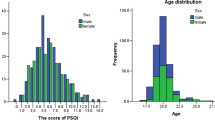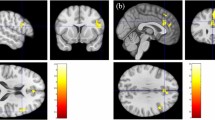Abstract
The role of brain regions in the relationship between psychological stress and sleep quality is unclear. This study investigates the neuroanatomical basis of the association between psychological stress and sleep quality. Data were collected using the Pittsburgh Sleep Quality Index, the Psychosomatic Tension Relaxation Inventory, and voxel-based morphometry among 318 healthy students. The results showed that psychological stress was negatively correlated with sleep quality. According to the mediation analysis results, the correlation between psychological stress and sleep quality was partially mediated by the region of the bilateral inferior temporal gyrus. These findings suggest that there is a strong link between sleep quality and psychological stress, highlighting the gray matter volume of the bilateral inferior temporal gyrus related to emotional processing, which plays an essential role in improving sleep quality.




Similar content being viewed by others
References
Almojali, A. I., Almalki, S. A., Alothman, A. S., Masuadi, E. M., & Alaqeel, M. K. (2017). The prevalence and association of stress with sleep quality among medical students. Journal of Epidemiology and Global Health, 7(3), 169–174.
Amaral, A. P., Soares, M. J., Pinto, A. M., Pereira, A. T., Madeira, N., Bos, S. C., Marques, M., Roque, C., & Macedo, A. (2018). Sleep difficulties in college students: The role of stress, affect and cognitive processes. Psychiatry Research, 260, 331–337.
Anderheim, L., Holter, H., Bergh, C., & Möller, A. J. H. R. (2005). Does psychological stress affect the outcome of in vitro fertilization? Human Reproduction, 20(10), 2969–2975.
Ashburner, J. (2007). A fast diffeomorphic image registration algorithm. NeuroImage, 38(1), 95–113.
Ashburner, J., & Friston, K. J. (2005). Unified segmentation. Neuroimage, 26(3), 839–851.
Bartel, K. A., Gradisar, M., & Williamson, P. (2015). Protective and risk factors for adolescent sleep: A meta-analytic review. Sleep Medicine Reviews, 21, 72–85.
Beauregard, M., Chertkow, H., Bub, D., Murtha, S., Dixon, R., & Evans, A. (1997). The neural substrate for concrete, abstract, and emotional word lexica a positron emission tomography study. Journal of Cognitive Neuroscience, 9(4), 441–461.
Bell-McGinty, S., Habeck, C., Hilton, H. J., Rakitin, B., Scarmeas, N., Zarahn, E., Flynn, J., DeLaPaz, R., Basner, R., & Stern, Y. (2004). Identification and differential vulnerability of a neural network in sleep deprivation. Cerebral Cortex, 14(5), 496–502.
Brüning, F., Noya, S. B., Bange, T., Koutsouli, S., Rudolph, J. D., Tyagarajan, S. K., Cox, J., Mann, M., Brown, S. A., & Robles, M. S. (2019). Sleep-wake cycles drive daily dynamics of synaptic phosphorylation. Science, 366, 6462.
Buysse, D. J., Germain, A., Hall, M., Monk, T. H., & Nofzinger, E. A. (2011). A neurobiological model of insomnia. Drug Discovery Today: Disease Models, 8(4), 129–137.
Buysse, D. J., Reynolds, C. F., Monk, T. H., Berman, S. R., & Kupfer, D. J. (1989). The Pittsburgh Sleep Quality Index: A new instrument for psychiatric practice and research. Psychiatry Research, 28(2), 193–213.
Chen, S. H., Hung, F. C., Lin, Y. S., & Tseng, H. M. (2002). Trauma and psychosocial aftermath among high-and low-exposure adults three months post the 921 Chi-Chi earthquake in Taiwan. Chinese Journal of Psychology, 44(2), 167–188.
Cirelli, C., & Tononi, G. (2019). Linking the need to sleep with synaptic function. Science, 366(6462), 189–190.
Dang-Vu, T. T., Zadra, A., Labelle, M. A., Petit, D., Soucy, J. P., & Montplaisir, J. (2015). Sleep deprivation reveals altered brain perfusion patterns in somnambulism. PloS one, 10(8), e0133474.
Drevets, W. C., Price, J. L., & Furey, M. L. (2008). Brain structural and functional abnormalities in mood disorders: Implications for neurocircuitry models of depression. Brain Structure and Function, 213(1–2), 93–118.
Drummond, S. P., & Brown, G. G. (2001). The effects of total sleep deprivation on cerebral responses to cognitive performance. Neuropsychopharmacology, 25(5), 68–73.
Du, L., Wang, J., Meng, B., Yong, N., Yang, X., Huang, Q., Zhang, Y., Yang, L., Qu, Y., Chen, Z., & Li, Y. (2016). Early life stress affects limited regional brain activity in depression. Scientific Reports, 6(1), 1–8.
Feldman, P. J., Cohen, S., Hamrick, N., & Lepore, S. J. (2004). Psychological stress, appraisal, emotion and cardiovascular response in a public speaking task. Psychology & Health, 19(3), 353–368.
Gianaros, P. J., Jennings, J. R., Sheu, L. K., Greer, P. J., Kuller, L. H., & Matthews, K. A. (2007). Prospective reports of chronic life stress predict decreased grey matter volume in the hippocampus. NeuroImage, 35(2), 795–803.
Han, K. S., Kim, L., & Shim, I. (2012). Stress and sleep disorder. Experimental Neurobiology, 21(4), 141–150.
Hayes, A. F. (2013). Introduction to mediation, moderation, and conditional process analysis: A regression-based approach. Guilford publications.
Joo, E. Y., Tae, W. S., Lee, M. J., Kang, J. W., Park, H. S., Lee, J. Y., Suh, M., & Hong, S. B. (2010). Reduced brain gray matter concentration in patients with obstructive sleep apnea syndrome. Sleep, 33(2), 235–241.
Kähkönen, S., Yamashita, H., Rytsälä, H., Suominen, K., Ahveninen, J., & Isometsä, E. (2007). Dysfunction in early auditory processing in major depressive disorder revealed by combined MEG and EEG. Journal of Psychiatry & Neuroscience: JPN, 32(5), 316.
Kanai, R., & Rees, G. (2011). The structural basis of inter-individual differences in human behaviour and cognition. Nature Reviews Neuroscience, 12(4), 231–242.
Kogler, L., Müller, V. I., Chang, A., Eickhoff, S. B., Fox, P. T., Gur, R. C., & Derntl, B. (2015). Psychosocial versus physiological stress—Meta-analyses on deactivations and activations of the neural correlates of stress reactions. NeuroImage, 119, 235–251.
Kurebayashi, L. F. S., Do Prado, J. M., & Da Silva, M. J. P. (2012). Correlations between stress and anxiety levels in nursing students. Journal of Nursing Education and Practice, 2(3), 128.
Lazarus, R. S., & Folkman, S. (1984). Stress, appraisal, and coping. Springer.
Lee, S. Y., Wuertz, C., Rogers, R., & Chen, Y. P. (2013). Stress and sleep disturbances in female college students. American Journal of Health Behavior, 37(6), 851–858.
Li, X., & Hu, L. (2016). The role of stress regulation on neural plasticity in pain chronification. Neural plasticity, 2016.
Li, Y., Gu, S., Wang, Z., Li, H., Xu, X., Zhu, H., Deng, S., Ma, X., Feng, G., Wang, F., & Huang, J. H. (2019). Relationship between stressful life events and sleep quality: Rumination as a mediator and resilience as a moderator. Frontiers in Psychiatry, 10, 348.
Lin, Y. H., Young, I. M., Conner, A. K., Glenn, C. A., Chakraborty, A. R., Nix, C. E., Bai, M. Y., Dhanaraj, V., Fonseka, R. D., Hormovas, J., & Tanglay, O. (2020). Anatomy and white matter connections of the inferior temporal gyrus. World Neurosurgery, 143, e656–e666.
Medic, G., Wille, M., & Hemels, M. E. (2017). Short-and long-term health consequences of sleep disruption. Nature and Science of Sleep, 9, 151.
Näätänen, R., Pakarinen, S., Rinne, T., & Takegata, R. (2004). The mismatch negativity (MMN): Towards the optimal paradigm. Clinical Neurophysiology, 115(1), 140–144.
Perlis, M. L., Giles, D. E., Mendelson, W. B., Bootzin, R. R., & Wyatt, J. K. (1997). Psychophysiological insomnia: The behavioural model and a neurocognitive perspective. Journal of Sleep Research, 6(3), 179–188.
Riemann, D., Spiegelhalder, K., Feige, B., Voderholzer, U., Berger, M., Perlis, M., & Nissen, C. (2010). The hyperarousal model of insomnia: A review of the concept and its evidence. Sleep Medicine Reviews, 14(1), 19–31.
Rosen, H. J., Allison, S. C., Schauer, G. F., Gorno-Tempini, M. L., Weiner, M. W., & Miller, B. L. (2005). Neuroanatomical correlates of behavioural disorders in dementia. Brain, 128(11), 2612–2625.
Sanford, L. D., Suchecki, D., & Meerlo, P. (2014). Stress, arousal, and sleep. In Sleep, neuronal plasticity and brain function (pp. 379–410). Springer.
Segerstrom, S. C., & Miller, G. E. (2004). Psychological stress and the human immune system: A meta-analytic study of 30 years of inquiry. Psychological Bulletin, 130(4), 601.
Shan, Z. Y., Kwiatek, R., Burnet, R., Del Fante, P., Staines, D. R., Marshall-Gradisnik, S. M., & Barnden, L. R. (2017). Medial prefrontal cortex deficits correlate with unrefreshing sleep in patients with chronic fatigue syndrome. NMR in Biomedicine, 30(10), e3757.
Short, M. A., Gradisar, M., Lack, L. C., Wright, H. R., & Dohnt, H. (2013). The sleep patterns and well-being of Australian adolescents. Journal of Adolescence, 36(1), 103–110.
Staner, L. (2003). Sleep and anxiety disorders. Dialogues in Clinical Neuroscience, 5(3), 249.
Sterling, P., & Eyer, J. (1988). Handbook of Life Stress, Cognition and Health. In S. Fisher & J. Reason (Eds.), Handbook of Life Stress. Cognition and Health: Wiley.
Takeuchi, H., Taki, Y., Sassa, Y., Hashizume, H., Sekiguchi, A., Nagase, T., Nouchi, R., Fukushima, A., & Kawashima, R. (2012). Regional gray and white matter volume associated with Stroop interference: Evidence from voxel-based morphometry. NeuroImage, 59(3), 2899–2907.
Varlinskaya, E. I., Spear, L. P., & Diaz, M. R. (2018). Stress alters social behavior and sensitivity to pharmacological activation of kappa opioid receptors in an age-specific manner in Sprague Dawley rats. Neurobiology of Stress, 9, 124–132.
Wallace, J. M. (1980). Behavioral health change through tension control learning in adult education classes. In F. J. McGuigan, W. E. Sime, & J. M. Wallace (Eds.), Stress and tension control (pp. 243–261). Springer.
Wang, Z., Liang, P., Jia, X., Jin, G., Song, H., Han, Y., Lu, J., & Li, K. (2012). The baseline and longitudinal changes of PCC connectivity in mild cognitive impairment: a combined structure and resting-state fMRI study. PLoS ONE, 7(5), e36838.
Zhang, L., Li, D., & Yin, H. (2020). How is psychological stress linked to sleep quality? The mediating role of functional connectivity between the sensory/somatomotor network and the cingulo-opercular control network. Brain and Cognition, 146, 105641.
Funding
This work was supported by the Research Foundation of Education Bureau of Hunan Province, China (Grant No. 18A029) and the Education Planning foundation of Hunan Province, China (Grant No. XJK20AXL01).
Author information
Authors and Affiliations
Contributions
LZ and GC conducted the studies, DL and HY provided substantive ideas, LZ, GC and YB collected and analyzed the data, LZ, GC, DL, YB, ZL, JL, and HY prepared and revised the manuscript.
Corresponding authors
Ethics declarations
Conflict of interest
On behalf of all authors, the corresponding author states that there is no conflict of interest.
Informed consent
All procedures followed were in accordance with the Helsinki Declaration of 1975, and the applicable revisions at the time of the investigation. Informed consent was obtained from all participants included in the study.
Additional information
Publisher's Note
Springer Nature remains neutral with regard to jurisdictional claims in published maps and institutional affiliations.
Rights and permissions
About this article
Cite this article
Zhang, L., Cao, G., Liu, Z. et al. The gray matter volume of bilateral inferior temporal gyrus in mediating the association between psychological stress and sleep quality among Chinese college students. Brain Imaging and Behavior 16, 557–564 (2022). https://doi.org/10.1007/s11682-021-00524-6
Accepted:
Published:
Issue Date:
DOI: https://doi.org/10.1007/s11682-021-00524-6




